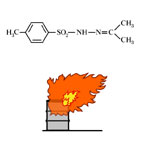| Case Name |
Spontaneous ignition of p-toluenesulfonyl hydrazone at temporary storage |
| Pictograph |

|
| Date |
January 1, 1970 |
| Place |
Osaka, Osaka, Japan |
| Location |
Chemical factory |
| Overview |
The p-toluenesulfonyl hydrazone was dried, filled into paper bags, and piled up on the day before the fire. The work was completed at 16:00. Fire broke out before dawn on the next day. Since remaining heat can cause a fire by accelerating exothermic reactions, the operation procedure was revised to store p- toluenesulfonyl hydrazone after cooling. |
| Incident |
Fire broke out before dawn from the p-toluenesulfonyl hydrazone, which was piled up in paper bags after being dried. |
| Processing |
Storage |
| Process Flow |
Fig2.Unit process flow
|
| Substance |
p-toluenesulfonyl hydrazone, Fig3 |
| Type of Accident |
Fire |
| Sequence |
The p-toluenesulfonyl hydrazone was dried, filled into paper bags, and piled up on the day before the fire. Work was completed at 16:00. Fire broke out before dawn on the next day. |
| Cause |
Heat accumulation due to packing at a high temperature and acceleration of a decomposition reaction caused by free acid that might have contaminated at manufacturing were the assumed causes. |
| Countermeasures |
Standardization of work procedure |
| Knowledge Comment |
Powder with reactivity can cause ignition and decomposition when it is accumulated under high temperature condition. It is important to confirm thermo-physical properties and reactivity of the material under the handling conditions in advance. |
| Background |
Non-standardization of operational procedure could be the main cause. In the 1970s, it can be assumed that factory management might have had a weak awareness of the necessity to standardize work procedures or might not have recognized the danger of the material. |
| Reason for Adding to DB |
Typical case of ignition caused due to heat accumulation |
| Scenario |
| Primary Scenario
|
Poor Value Perception, Poor Safety Awareness, Insufficient Recognition of Risk, Carelessness, Insufficient Understanding, Insufficient Understanding of Risk, Planning and Design, Poor Planning, Poor Schedule Planning in Manual, Bad Event, Chemical Phenomenon, Heat Accumulation, Secondary Damage, External Damage, Fire
|
|
| Sources |
Masamitsu Tamura. Wakakura Masahide. Ignition of the p-toluenesulfonyl hydrazone. The reaction danger - Accident case and analysis- p.151(1995).
|
| Physical Damage |
The depot in the chemical factory was damaged by fire. |
| Multimedia Files |
Fig3.Chemical formula
|
| Field |
Chemicals and Plants
|
| Author |
WAKAKURA, Masahide (Kanagawa Industrial Technology Research Institute)
TAMURA, Masamitsu (Center for Risk Management and Safety Sciences, Yokohama National University)
|